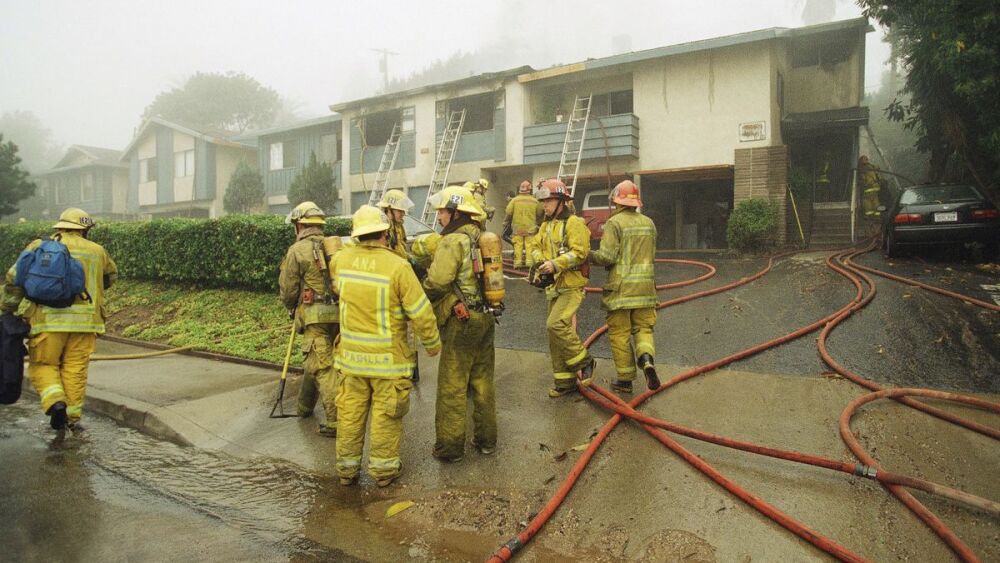The movie “Backdraft” premiered in 1991, quickly becoming a fire service cult classic. The appeal of the movie may lie with the raw fatalism of the principal character “Bull,” played by Kurt Russell. Bull is a tough, no-nonsense Chicago fire captain with his own personal views of what a firefighter is supposed to be and how a fire is to be attacked. Some others, including an estranged wife, see him as reckless. Bull and his way of doing things represents the old-school, and he clashes with anybody who doesn’t see things his way.
Old school vs. new school
Look closely at firefighting photos from the 1990s, and many reveal a fire service in transition, a transition where safety-consciousness confronts old-school ways of doing things. Photos show departments wearing varying types of turnout gear, some older and some newer; 2½-inch and 3-inch supply lines; decades-old apparatus; and various ways of wearing (or not wearing) SCBA. You might not see any safety officers or designated command posts in photos from this era.
If the takeaway from the 1980s is a recognition of the connection between risk and liability, the 90s represents the large-scale effort to reduce risks and mitigate liability. But make no mistake, many firefighters in the 1990s were bemoaning, even resisting, efforts to make firefighting safer.
Safety in firefighting was held to be an impossible ask, a novel management idea put forth by people who know nothing about real firefighting, and an impractical burden on individual firefighters. How could one expect to be safe in the course of fighting a fire when risk is inherent to fire attack? After all, taking risks is part of the job.
At one point, there seemed to be two camps – those who believed in prioritizing safety and those who resisted new safety measures. The transition only succeeded as fire service leaders convinced followers and through directed safety-change efforts by organizations such as the NFPA, IAFF, IAFC and OSHA. The safety mindset took a firm hold when finally integrated into basic firefighter and officer training. And it was cemented when manufacturers began making apparatus and equipment with safety built into the design.
In those old images, look at the mix of apparatus, the remaining open-cabs and the new closed crew cab trucks. With turnout gear, look for crew wearing three-quarter hip-length rubber boots versus short boots and bunker pants. Helmets also changed or evolved as new designs incorporated improved impact resistance. Also look at station uniforms. Wearing fire-resistive turnouts over combustible station uniforms made little sense. In response, the NFPA developed Standard 1975 specifying criteria for station-wear.
Visibility at incident scenes gained emphasis with reflective striping added to helmets, turnout gear and apparatus. The efforts went as far as some departments painting the apparatus lime-green in response to studies touting the increased visibility over traditional red. Lime-green vehicles, however, never really caught on except for airport fire departments in general.
New fire stations featured more privacy in crew quarters, functional kitchens, and ventilation systems. One cannot fully appreciate the effort to improve fire station quarters unless you’ve worked in an older, early- or mid-20th century fire station with little physical separation between the apparatus and the bunk room and kitchen, no air conditioning, and no exhaust ventilation for the trucks.
The success of safety efforts is due largely to leadership. All the guidelines, rules and national standards mean little without the support of leadership – and the leaders’ implementation efforts. Someone has to make sense of it all and make the rational argument for wholesale change. Applying lessons learned and using standard operating procedures (SOPs) proved vital in the transition to a more safety-conscious fire service.
One fire service leader in particular, Chief Alan Brunacini, is due much of the credit for shaping the future of the fire service with a more safety-focused approach. When he merged the idea of having a process for command and control with safety, the die was cast. There would be no turning back to the old ways.
The most difficult leadership challenge was to somehow rein in freelancing without quashing individual initiative in the process. After all, it is individual initiative that often saves the day. It takes experienced leaders to allow (manage) the initiative and at the same time restrain individual freelancing.
911 stretches across the country
With most homes having telephone service, cities and towns were able to remove street boxes from the municipal fire telegraph circuit – an act that also limited the number of false alarm calls. At the same time, volunteer departments found the traditional means of summoning firefighters to a call, the horns and sirens mounted atop the firehouse roof, becoming less effective. Many of these warning devices were throwbacks to the national civil defense warning system of the Cold War years. People were ready to move beyond these antiquated systems in favor of tone-alert paging systems and personal pagers.
Miniaturization of communications equipment brought advances in the portability of two-way radios and effectiveness of tone-alert paging systems. In 1957, some fire chiefs proposed one nationwide emergency telephone number for reporting fires. Ten years later, a presidential commission recommended one national number for reporting all types of emergencies. Working with the FCC, AT&T in 1968 established 911 as the number to be used throughout the country.
They chose 911 because it was brief, easily remembered, quickly dialed. Importantly, the three numbers had never been used as an area code, office code or service code. Congress backed AT&T’s proposal with legislation allowing use of only the numbers 911 for emergency calling services nationwide. By the end of the 90s, nearly 93% of the population of the United States was covered by some type of 911 service, with the vast majority of systems using Enhanced-911 (E-911) technology to automatically provide the caller’s location to dispatchers.
Working together
In 1998, OSHA Standard 29 CFR 1910.134 – the federal safety rules covering occupational respiratory protection – included a controversial provision mandating the two-in/two-out rule for interior structural fire attack. The rule was made with the backing of the major fire service organizations. With the weight of a federal rule, OSHA 1910.134 compliance was seen as the only way to gain a level of occupational safety and health that the fire service might never have achieved on its own.
By the end of the 1990s, the fire service had evolved, for the most part successfully, into a highly respected public emergency service. The changes played out over three decades, and one generation of firefighters had experienced all of it. America’s firefighters were now better trained and equipped for the future but ever mindful and proud of their past.
But a major challenge loomed on the horizon. The decline in the number of volunteer firefighters was causing concern in light of the two-in/two-out rule. Some understaffed departments attacked fires with fewer personnel than allowed under the OSHA rule. Combination departments and many career departments with less-than-ideal staffing had long depended on volunteers. Mutual aid, both formal and informal, had long been part of the fire service and played a significant role in getting enough firefighters to major incidents. But with declining volunteer numbers, mutual aid was not always timely, especially where time was a factor.
Fortunately, the advances in two-way radios, page-alerting technology and computer-aided dispatch (CAD) made deploying fire departments over a region more manageable. This allowed fire service leaders to take the concept of mutual aid and expand it into automatic aid. Dispatching additional first-alarm units across a region meant a greater probability of getting enough firefighters on initial response. More firefighters allowed two-in/two-out for an initial attack line and a backup line. As automatic aid proved its value providing sufficient personnel for a response, departments also made rapid-intervention teams (RIT) part of their automatic aid agreements.
Getting ready for the challenges ahead
By the end of the 1990s, the fire service was trained and equipped – ready – for the challenges ahead in the 21st century. The first decade of the new century saw the changes slowly implemented. The changeover was slow, however, in part because attitudes had to adapt, but the real impediment was a critical lack of fiscal support for implementation efforts. The needed capital would come eventually, much of it in the form of federal homeland security grants, in the wake of a terrorist attacks on September 11, 2001. That day forever changed the American fire service.
Read next:
Change is inevitable: A brief history of the 1980s fire service
Technology, NFPA standards and a visionary leader drove key changes to help extinguish antiquated operations
Read next:
The ‘War Years’: A brief history of the 1970s fire service
“America Burning” spotlights firefighters, legends propose new tactics, and smoke detectors change the game
















